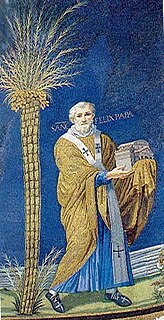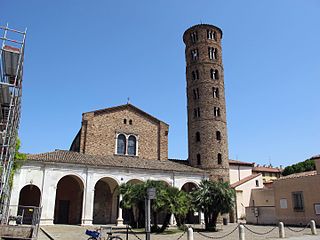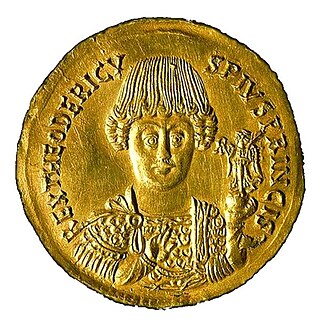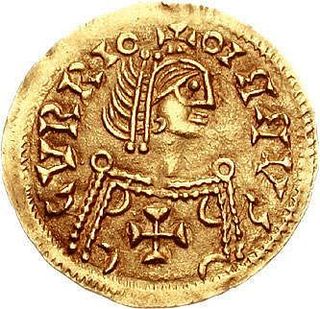Related Research Articles

The Ostrogoths were a Roman-era Germanic people. In the 5th century, they followed the Visigoths in creating one of the two great Gothic kingdoms within the Roman Empire, based upon the large Gothic populations who had settled in the Balkans in the 4th century, having crossed the Lower Danube. While the Visigoths had formed under the leadership of Alaric I, the new Ostrogothic political entity which came to rule Italy was formed in the Balkans under the influence of the Amal Dynasty, the family of Theodoric the Great.

Theodoricthe Great, also called Theodoric the Amal, was king of the Ostrogoths (471–526), and ruler of the independent Ostrogothic Kingdom of Italy between 493 and 526, regent of the Visigoths (511–526), and a patrician of the East Roman Empire. As ruler of the combined Gothic realms, Theodoric controlled an empire stretching from the Atlantic Ocean to the Adriatic Sea. Though Theodoric himself only used the title 'king' (rex), some scholars characterize him as a Western Roman Emperor in all but name, since he ruled large parts of the former Western Roman Empire, had received the former Western imperial regalia from Constantinople in 497, and was referred to by the title augustus by some of his subjects.

Year 526 (DXXVI) was a common year starting on Thursday of the Julian calendar. At the time, it was known as the Year of the Consulship of Olybrius without colleague. The denomination 526 for this year has been used since the early medieval period, when the Anno Domini calendar era became the prevalent method in Europe for naming years.

Flavius Odoacer, also spelled Odovacer or Odovacar, was a soldier and statesman of barbarian background, who deposed the child emperor Romulus Augustulus and became King of Italy (476–493). Odoacer's overthrow of Romulus Augustulus is traditionally seen as marking the end of the Western Roman Empire as well as Ancient Rome.

Ravenna is the capital city of the Province of Ravenna, in the Emilia-Romagna region of Northern Italy. It was the capital city of the Western Roman Empire from 402 until the empire collapsed in 476. It then served as the capital of the Ostrogothic Kingdom until it was re-conquered in 540 by the Byzantine Empire. Afterwards, the city formed the centre of the Byzantine Exarchate of Ravenna until the last exarch was executed by the Lombards in 751. Although it is an inland city, Ravenna is connected to the Adriatic Sea by the Candiano Canal. It is known for its well-preserved late Roman and Byzantine architecture, with eight buildings comprising the UNESCO World Heritage Site "Early Christian Monuments of Ravenna".
Pope John I was the bishop of Rome from 13 August 523 to his death. He was a native of Siena, in Italy. He was sent on a diplomatic mission to Constantinople by the Ostrogoth King Theoderic to negotiate better treatment for Arians. Although John was relatively successful, upon his return to Ravenna, Theoderic had him imprisoned for allegedly conspiring with Constantinople. The frail pope died of neglect and ill-treatment.

Flavius Ardabur Aspar was an Eastern Roman patrician and magister militum of Alanic-Gothic descent. As the general of a Germanic army in Roman service, Aspar exerted great influence on the Eastern Roman Emperors for half a century, from the 420s to his death in 471, through the reigns of Theodosius II, Marcian and Leo I, who, in the end, had him killed. His death led to the ending of the Germanic domination of Eastern Roman policy.
Epiphanius was the Ecumenical Patriarch of Constantinople from February 25, 520 to June 5, 535, succeeding John II Cappadocia.

Witteric was the Visigoth King of Hispania, Septimania and Galicia. He ruled from 603 to 610.

The Basilica of Sant'Apollinare Nuovo is a basilica church in Ravenna, Italy. It was erected by the Ostrogothic king Theodoric the Great as his palace chapel during the first quarter of the 6th century. This Arian church was originally dedicated in 504 AD to "Christ the Redeemer".

The Arian Baptistry in Ravenna, Italy is a Christian baptismal building that was erected by the Ostrogothic King Theodoric the Great between the end of the 5th century and the beginning of the 6th century A.D., at the same time as the Basilica of Sant' Apollinare Nuovo.

The Ostrogothic Kingdom, officially the Kingdom of Italy, was established by the Germanic Ostrogoths in Italy and neighboring areas from 493 to 553.

Rechiar or Rechiarius was the Suevic king of Gallaecia from 448 until his death. He was the first Chalcedonian Christian (Catholic) Germanic king in Europe and one of the most innovative and belligerent of the Suevi monarchs. Despite his orthodox Christianity, Hydatius, the contemporary bishop and chronicler from Galicia who is the sole contemporary source for biographical details of Rechiar, established his reputation as that of a barbarian with little sense of Roman law, culture, or custom.
Remismund was the Suevic king of Galicia from c. 464 until his death.

The Visigothic Kingdom, officially the Kingdom of the Goths, was a kingdom that occupied what is now southwestern France and the Iberian Peninsula from the 5th to the 8th centuries. One of the Germanic successor states to the Western Roman Empire, it was originally created by the settlement of the Visigoths under King Wallia in the province of Gallia Aquitania in southwest Gaul by the Roman government and then extended by conquest over all of Hispania. The Kingdom maintained independence from the Eastern Roman or Byzantine Empire, whose attempts to re-establish Roman authority in Hispania were only partially successful and short-lived.
Ajax was an Arian missionary to the pagan Suevi of Galicia who converted them to Christianity in 464 or 466.

The Ostrogothic Papacy was a period from 493 to 537 where the papacy was strongly influenced by the Ostrogothic Kingdom, if the pope was not outright appointed by the Ostrogothic King. The selection and administration of popes during this period was strongly influenced by Theodoric the Great and his successors Athalaric and Theodahad. This period terminated with Justinian I's (re)conquest of Rome during the Gothic War (535–554), inaugurating the Byzantine Papacy (537-752).
Ostrogothic Ravenna refers to the time period in which Ravenna, a city in Northeastern Italy, served as the capital of the Ostrogothic Kingdom, which existed between 493 and 553 CE. During that time, Ravenna saw a great renovation, in particular under Theodoric the Great (454–526). During his rule, Ravenna saw many of its finest monuments constructed or renovated, including the Basilica of Sant'Apollinare Nuovo, the Palace of Theoderic, and Mausoleum of Theodoric. Many of these monuments reflect the Arian faith of Theodoric and the Goths. Though an Arian Christian himself, Theodoric's rule was a time of religious tolerance in the city of Ravenna. His religious tolerance extended also to forging a balance between the Romans and Goths in Ravenna. Theodoric attempted to model Ravenna as a capital equivalent to that of Rome or Constantinople and as such was a defender of classical antiquity in a western world that saw much of its classical heritage disappearing.
Tirida, also known as Stabulum Diomedis or Stabulo Diomedis, was a town of ancient Thrace. Pliny the Elder writes "Oppidum fuit Tirida, Diomedis equorum stabulis dirum." This Diomedes was the king of the Bistones who was in the habit of throwing strangers to be devoured by his savage horses, till at length he himself was punished in the same way by Heracles. Based on the passage of Pliny, William Smith identified Tirida with the town called Stabulum Diomedis in the Itineraries, that was located on the coast of Thrace on the Via Egnatia, 18 M.P. according to the Antonine Itinerary, 12 M.P. according to the Jerusalem Itinerary, from Porsula. Also in the 19th century, William Hazlitt wrote that Stabulum Diomedis' site was that of the earlier Dicaea. Martial talks about Tyrida in his De nuptiis, noting that it was located near regio Maronea. Some have suggested the town belonged to Geto-Dacian enclave.

Christianization of the Franks was the process of converting the pagan Franks to Catholicism during the late 5th century and early 6th century. It was started by Clovis I, regulus of Tournai, with the insistence of his wife, Clotilde and Saint Remigius, the bishop of Reims.
References
- ↑ St. Pomponius Catholic Online